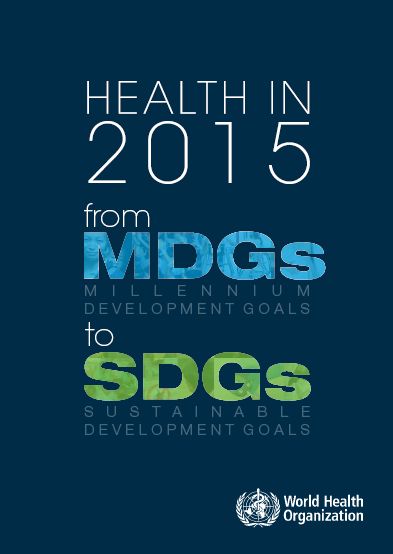
WHO
launched a new comprehensive analysis of global health trends titled: Health in
2015: from MDGs to SDGs
On
8 December 2015, WHO launched a new comprehensive analysis of global health
trends since 2000 and an assessment of the challenges for the next 15 years
which came into effect on 1 January 2016.
"Health
in 2015: from MDGs to SDGs" identifies the key drivers of progress in
health under the United Nations Millennium Development Goals (MDGs). It lays
out actions that countries and the international community should prioritize to
achieve the new Sustainable Development Goals (SDGs), which come into effect on
1 January 2016. The 17 SDGs are broader and more ambitious than the MDGs,
presenting an agenda that is relevant to all people in all countries to ensure
that "no one is left behind." The new agenda requires that all 3
dimensions of sustainable development – economic, social and environmental –
are addressed in an integrated manner.
Almost all
the SDGs are directly related to health or will contribute to health
indirectly. One goal (SDG3) specifically sets out to “Ensure healthy lives and
promote well-being for all at all ages.” Its 13 targets build on progress made
on the MDGs and reflect a new focus on noncommunicable diseases and the
achievement of universal health coverage.
"Universal
health coverage cuts across all of the health-related goals," says Dr
Marie-Paule Kieny, Assistant Director-General of Health Systems and Innovation
at WHO. "It is the linchpin of development in health and reflects the SDGs
strong focus on equity and reaching the poorest, most disadvantaged people
everywhere."
Key
ingredients for success included a doubling in global funding for health, the
creation of new funding mechanisms and partnerships, and the critical role of
civil society in tackling diseases such as HIV/AIDS. Research investments led
to the scale-up in all countries of new interventions such as antiretroviral
therapy for HIV treatment and insecticide-treated bed nets to prevent malaria.
The
WHO report presents the latest data and in-depth analysis for the key areas
outlined in the health SDGs:
-
reproductive, maternal, newborn,
child and adolescent health;
-
infectious diseases including HIV,
tuberculosis, malaria, hepatitis and neglected tropical diseases;
-
noncommunicable diseases (NCDs)
including heart disease, cancer and diabetes;
-
mental health and substance use
including narcotics and harmful use of alcohol;
-
injuries and violence; and
-
universal health coverage.
"Snapshots"
on 34 different health topics outline trends, achievements made, reasons for
success, challenges and strategic priorities for improving health in the
different areas. These "snapshots" range from air pollution to
hepatitis to road traffic injuries.
In this
report, WHO also explores how health contributes to and benefits from the other
16 SDGs and examines the implications of emerging issues such as technological
and environmental change on global health.
WHO is
working with partners to establish a Health Data Collaborative in early 2016
that aims to support countries to build better health data systems. An early
product of this global collaboration is the "WHO Global Reference List of
100 Core Indicators", published earlier this year, which is already being
used to guide work in many countries.
"As the
global agency with the mandate to cover the whole health agenda, WHO will take
a leading role in supporting countries to set their own national targets and
strategies, advising on best-buy interventions, defining research priorities
and monitoring progress in achieving the health-related SDGs," says Dr
Kieny.
In 2016, WHO
will publish the first in a series of annual reports on the SDGs to set the
baseline and measure progress towards achieving the goals over the next 15
years.
To read the
report, please click here
Dr. Shima
Naghavi, Director of International Affairs